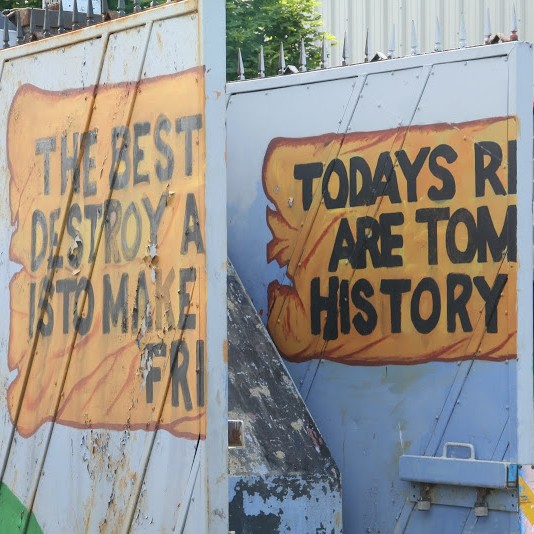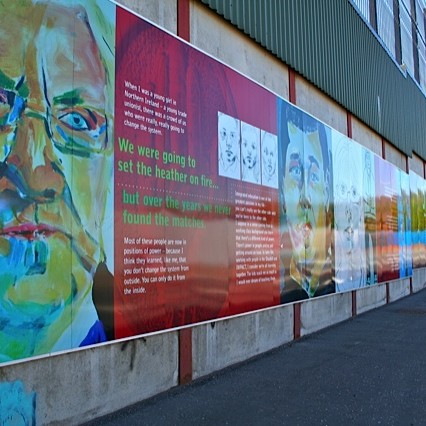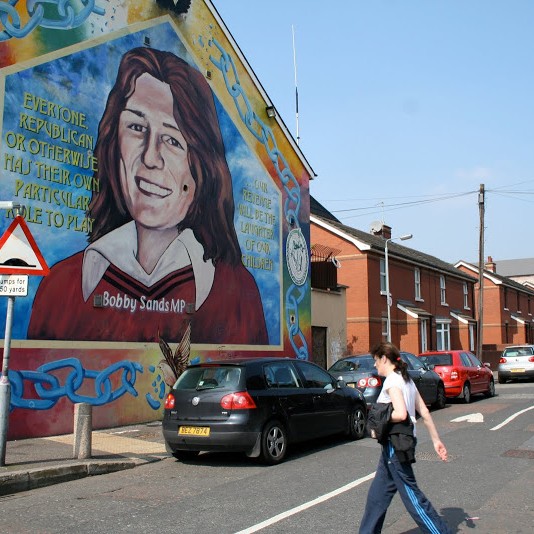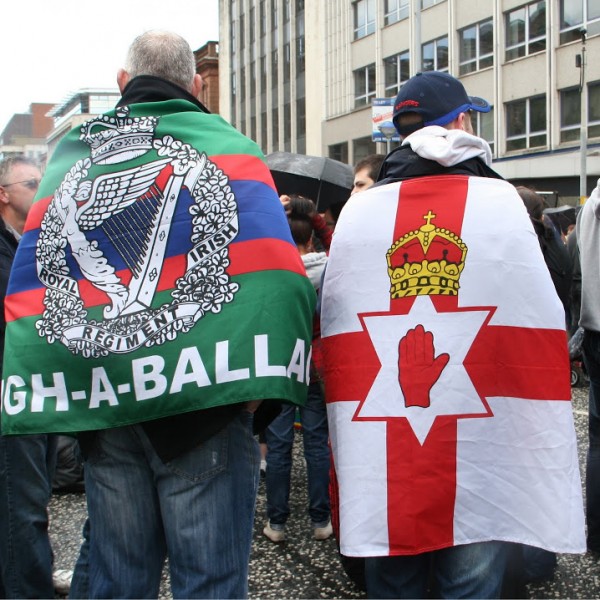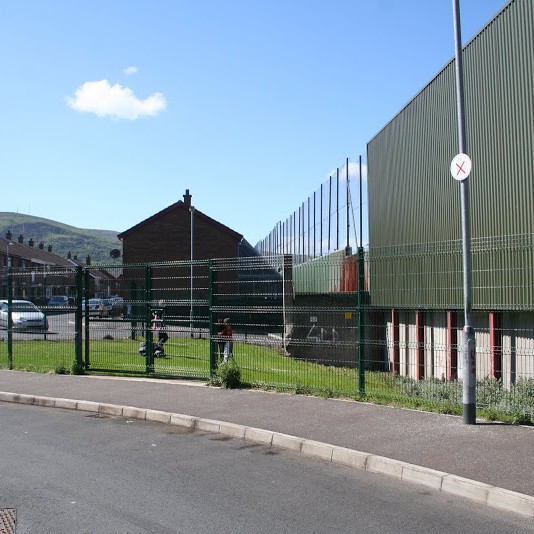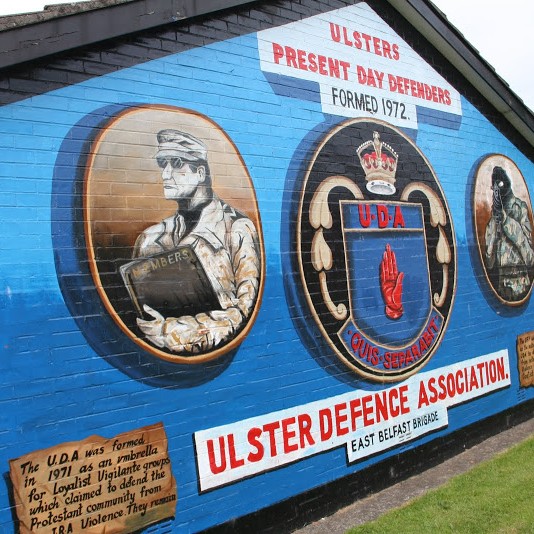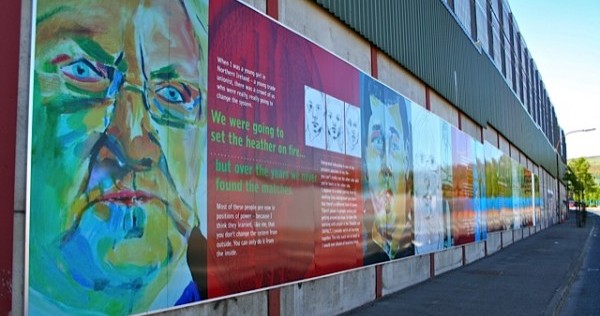
The Number 1 city bus up the Antrim Road is a leap into Belfast’s troubled past and still-turbulent present. Like all bus routes in Northern Ireland’s capital city, the Number 1 starts downtown amid glass-and-steel high-rises, trendy shops, and cafés. Locals, international business travelers, and tourists mingle on streets newly adorned with two-story-high curved copper ribs intended to evoke the city’s maritime heritage, including the building of the Titanic, launched here on May 31, 1911.
Once outside these 10 blocks, however, the Number 1 crosses what might as well be an astral divide. Belfast is one of the most segregated cities in the world, an occasionally Molotov cocktail-bombed landscape of “interfaces” and “peace walls” that have grown higher, longer, and more numerous in the 13 years since the Good Friday Agreement. The 1998 settlement formally ended the three decades of violence called The Troubles.
In Belfast, an interface is where Protestant and Catholic communities battle and, in the best of times, grimly turn their backs on one another. According to the Belfast Interface Project, there are at least 10 in the one-mile stretch between the place where the Number 1 starts and the city’s lone synagogue north of downtown. If you go the same distance east and west, the number of interfaces easily triples.
At first, interfaces are hard to spot. Uniformed schoolchildren get on and off the bus as they do in any metropolis. Mothers with strollers equipped with plastic shields (for the frequent rain showers) wrestle the carriers to the bays behind the driver and then wrestle them off.
But interfaces quickly become obvious, even to visitors. Snapping in the salty breeze, red-white-and-blue flags mark a Protestant Unionist neighborhood loyal to the British queen, her Union Jack, and the United Kingdom. Across the interface, Catholics and Nationalists who yearn for a united Ireland do errands under the gaze of glowering, ski-masked gunmen depicted in a mural topped by the Irish tricolors. Many Protestants embrace Rangers, a Glasgow-based soccer team. The most visible fans are copiously tattooed men who congregate and smoke in front of a pub as they show off their muscles in light-blue Rangers shirts. In contrast, musclemen in front of Catholic pubs, loyal to the Glasgow team that has a Catholic fan base, wear Celtic-knot tattoos and shamrock-green Celtic shirts.
Belfast boosters want visitors to focus on the Titanic and the paddywhackery of the pub crawl. Yet there is brisk business in so-called dark tourism, where guides explain the murals celebrating people like Bobby Sands, a member of the Irish Republican Army (IRA) and hunger striker elected to Parliament on April 9, 1981. He died of starvation 25 days later, in prison. In Protestant areas, memorials to Britain’s horrific losses at the 1916 Battle of the Somme are common because Protestant volunteers from Ulster took some of the heaviest casualties. Throughout Belfast, images of gunmen conjured from thick paint point their automatic rifles at passersby. Although these threatening figures represent the past, there is no mistaking the fresh touchups that keep them vivid.
Despite a dedicated and creative peace effort, including millions of pounds spent for inquiries and security—not to mention a dozen years of hard, post-Troubles political work—minds and hearts remain staunchly divided here. The negotiations at the peace table were exhausting; to create peace on the ground is harder and comes at a staggering cost. The only thing more expensive, it sometimes seems, would be letting the violence that marked The Troubles continue.
Ninety percent of Belfast’s public housing is segregated on religious grounds. Since 1998, it has become more segregated, not less, and some communities without walls are petitioning for new walls to be built. The Berlin Wall came down after 28 years; Belfast’s walls have not only stood for 35 but proliferated. When the Good Friday accords were signed, an estimated 20 walls stood; 13 years later there are more than 80.
Ninety percent of all school-age children attend segregated schools—Catholics in private, tuition-free, church-run institutions and Protestants in public schools. City planners often dole out resources in pairs: sports centers, clinics, parks, fire stations. If the city doesn’t duplicate services, the results can be dire. A friend of mine who lives on the Unionist Shankill Road once drove an ailing family member on a 45-minute detour to get to the Royal Victoria Hospital, since the traffic gates on the West Belfast peace wall, open during the day, shut at midnight. The hospital is on the Falls Road, firmly Nationalist. “Thank God she survived, but that’s the reality of daily life here,” he told me.
The payout for parallel services, at a time when Westminster is slashing spending, is immense. According to government figures, state spending per head in Northern Ireland is even higher than in England’s economically depressed Northeast. “At an estimated cost of £1 billion [$1.6 billion] per year, division affects everything from health to education to public transport, to access to services and—at times—two of everything literally a few streets apart,” wrote Deputy Chief Constable Judith Gillespie in a recent post on the Police Service of Northern Ireland’s blog. “This situation is not and should not be seen as normal.”
Most officials aren’t so frank. Instead of division, a term often used is shared space. Policymakers embrace shared space as the goal of the peace process, funneling more millions into nongovernmental and grassroots organizations that do cross-community work. Under the city’s often-gloomy skies, shared space is no abstraction. Where can locals go and be sure they won’t be threatened or attacked for their perceived identity? Or where in public can a football fan wearing a Rangers or Celtic shirt go and be sure he won’t be beaten up?
“Everyone talks about shared spaces, but that is a short-term solution,” says Dominic Bryan, a Queens University anthropologist who has studied the conflict. Every year since 2006, Bryan and a team of researchers have traveled the province counting public displays of flags in the weeks preceding July 12, the Protestant celebration of the 1690 victory of King William III over the Catholic King James at the River Boyne. Led by the Orange Lodges, Protestant flute bands flanked by mostly middle-aged men in bowler hats march along interface routes as an expression of identity as well as, it must be said, to batter Catholics with “kick-the-pope” lyrics:
Hullo, Hullo,
You’ll know us by our noise.
We’re up to our knees in Fenian blood.
Surrender or you’ll die.
The flags mark territory, according to Bryan, as well as identity and sectarian fervor. In five years of counting, the number and type of flags have remained stubbornly fixed. “So far,” he says, “shared has different meanings, including as long as you get yours, I’ll get mine. Everyone is treated equally, but separately.”
The communities—Catholic-Nationalist-Republican and Protestant-Unionist-Loyalist—remain in their respective corners like punch-drunk boxers. Northern Ireland has no truly shared space, no place where anyone can come at any time. One interpretation of shared space is what happens when Protestants and Catholics quietly trade off the small chunk that is central Belfast, ceding it one day to the Protestants for a military march and the next to the Catholics for a St. Patrick’s Day parade.
On a rainy Sunday this May, I walked with Shankill residents as Unionists from around the city converged on city hall to protest the decision not to hold a homecoming parade for the British Army’s Royal Irish Regiment after a six-month tour in Afghanistan. The 2008 homecoming parade had prompted a massive police operation devoted to keeping Unionist supporters and Nationalist protesters separated, so the appetite for a repeat near-riot was slight. As Unionists waved the regiment’s black-and-green flag, nary a Nationalist was to be found.
Longtime observers interpret this as a kind of progress because at least opponents aren’t maiming or killing one another. The Nationalists get the St. Patrick’s Day parade, which wasn’t celebrated until 1998, the year the Good Friday accord was signed. The Unionists get July 12, and so on. Public safety, one reason to limit shared space, is no mean goal in a province still grieving for the 3,500 killed and many more maimed in 30 years of The Troubles.
What is disturbing about segregation in Northern Ireland is not that there are tradeoffs; it’s that the people entrench themselves in segregated communities, and many of their leaders help them do it. For Americans, one analogy is to imagine what the South might look like had federal courts not forced integration in the face of violence. Certainly, the civil rights movement alone would have made some gains. But it’s also likely that states would have adapted in different ways, with some investing in segregation as a way of stemming violence. “Separate but equal” would be thought a virtue, not the disgrace we now understand it to be.
The most famous interface has a peace wall that separates the lower Springfield Road, part of the Catholic Falls, from the Protestant Shankill. The wall was never meant to be permanent. In 1969, it was a stretch of barbed wire hastily rolled out by British troops after clashes between Unionist and Nationalist communities left tiny Bombay Street a smoking ruin. Then came temporary dividers, then concrete topped by metal sheeting and more barbed wire. Today, a memorial marks the rebuilt Bombay Street, where new row houses back onto a wall that is more than 40 feet high and is under 24-hour TV police surveillance. Still, projectiles make it over. Residents encase their back porches in metal cages for protection.
Daniel Jacks is a pink-cheeked Republican who works with a cross-community peace project. When there is trouble, he says, kids born after the IRA’s formal ceasefire in 1994 usually create it. “They don’t really remember what it was like during The Troubles, but they think it was cool.” “Recreational riots” are frequent, he says. They happen when young people agree over Facebook or Bebo to start a melee.
A 2009 study by the Belfast-based Institute for Conflict Research found that kids still identify themselves along sectarian lines. It’s a question not of religious doctrine but of belonging—your people versus mine. When it comes time to confront, these young people are as handy with the slurs as their grandparents might have been, hurling such epithets as Huns (referring to the German origin of the British royal family) and Prods or Fenians (supporters of a united Ireland) and Taigs (from the Irish name Tahdg) along with bricks, bottles, and Molotov cocktails.
Most locals lament sectarianism and the walls. But they don’t want the walls removed. “Hugodecat,” posting on the popular political blog Slugger O’Toole, put popularly held feelings into this May 31 post:
I live on a peace line, and like many of my neighbouring home owners, we are quite happy to see it stay. It means that when trouble does brew we can sleep soundly and not worry about bricks through our windows and arson attacks. But I do understand that in many ways the walls are divisive, allowing the sectarian louts to perpetuate the myth that the human beings on the other side are somehow a different species.
In June, the province watched aghast as the worst rioting since The Troubles put East Belfast under a pall of greasy gasoline smoke for several nights. As the long summer day dimmed, youths with their faces masked under balaclavas pelted Catholic homes in Short Strand, just steps away from the city’s busy Central Station. Police riot vehicles went up in flames.
Many put the responsibility for the virulence of sectarianism squarely at the feet of Westminster, Stormont (the provincial parliament), and the province’s leading political parties. Protestants align increasingly behind the Democratic Union Party, and Catholics back IRA-linked Sinn Féin. A media-friendly cordiality goes on display when blood has been spilled. For instance, after the dissident Republicans known as the Real IRA murdered a Catholic police officer in April, “Shinner” Deputy Prime Minister Martin McGuinness, a one-time chief of staff of the Provisional IRA, urged people to provide the police with information. “These are people who are pledged to destroy the peace and destroy a peace process that many of us have invested much of our adult lives in trying to bring about,” he said during a press conference.
Yet there is also a stubborn unwillingness to accept that some of the past’s gruesome acts poison the present. The 1984 killing of Mary Travers is emblematic. She was a 23-year-old primary school teacher born and raised in Belfast. Her father, Tom, was a magistrate. That may not seem a dangerous profession, yet the Travers family was Catholic. To the IRA, any Catholics working for the state, especially the justice system, were traitors. A murder team shot the Travers family as they left church, injuring Tom and killing Mary. IRA militant Mary McArdle was quickly arrested, convicted, and sentenced to life. In May 2011, controversy erupted after McArdle—released under the terms of the Good Friday Agreement—was hired as a top adviser to Sinn Féin Culture Minister Carál Ní Chuilín. Mary Travers’s sister, Ann, gave a heart-wrenching interview to news channel UTV. “I just feel physically sick, disgusted,” she said. “I think about Mary every day. Then I hear one of the people involved in her murder is given a well-paid job at Stormont and it all comes crashing back.”
On the one hand, Sinn Féin insists that McArdle did prison time and worked on the party’s peace-building projects. Yet that is a coldblooded response to a family—and a people—still in agony. None of the actual shooters were ever identified or charged (McArdle was part of the getaway team). For her part, McArdle called the killing “a tragic mistake” and expressed regret but never apologized. A Belfast Telegraph editorial said the statement fell “far short of what is required. … The clear inference is that had Mr. Travers died and Mary been spared then the murderous mission would have been deemed a success.”
Combatants are understandably the first to justify their actions, the first to close the door on the past, and the first to accuse victims who want to revisit the past of wasting everyone’s time. Yet victims have given up more than anyone for peace and have so far received the least in exchange. In this case, the Travers family hasn’t even received elemental justice.
One of McArdle’s staunchest defenders is Gerry Kelly, a Shinner assemblyman who represents North Belfast. In 1973, Kelly planted four bombs in London, killing one person and injuring hundreds. On the other side of the interface, former Loyalist gunmen continue to “speak for” Unionist communities that, at best, see the gunmen as necessary evils—and at worst thugs who also traffic drugs, run prostitutes, and carry out criminal vendettas cloaked in patriotism. To be sure, barring anyone with a paramilitary past from working is foolish. At the same time, allowing assassins to go free is abhorrent.
There is some good news along the River Lagan. Despite the summer’s riots, violence is sharply down. The British troops that once patrolled are long gone. Most former gunmen and bomb makers have retired; many do good and necessary work in their communities or abroad as peacemakers. Although the Real IRA continues to launch attacks, no one doubts that the peace process is robust.
The unfortunate truth is that increased segregation may just well be the price of peace. Americans can hardly be surprised, since many of us have lived in communities segregated by race since before the Civil War. When one delegation from Israel visited Belfast recently, a friend told me that the earnest visitors grilled their Irish hosts for the secret-sauce recipe that brought peace to this corner of the Emerald Isle. Only partly in jest, my friend merrily replied, “Build a wall. It worked for us.”

